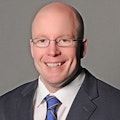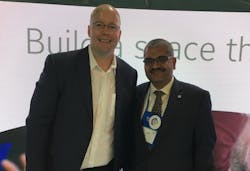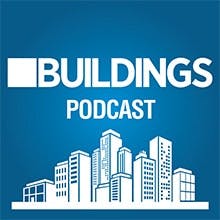AHR Expo: Ever-changing Environment of Facility Management
Straight from the “Inspiration Deck” on the second floor of the Johnson Control booth at AHR Expo 2019, Christoph Trappe speaks with Sudhi Sinha about what building owners and facility managers need to know about the continuously evolving industry.
Read the transcript below.
Christoph: Hello, everyone. Christoph Trappe here, chief content engagement director with BUILDINGS.com. I am at the AHR Expo in Atlanta and I’m joined by Sudhi Sinha, who is the VP & GM of Data Enabled Business, building technology and solutions at Johnson Controls. Thank you for joining us today.
Sudhi: Hello, Chris. How are you?
Christoph: I’m doing great. And thank you for making the time. We’re sitting here on the second floor of your booth. First time I think I’ve been on the second floor of a booth.
Sudhi: This is the first time we have done this, the second floor. We call it the “Inspiration Deck.” This is where we showcase all our future technologies and have conversations about the future.
Christoph: And so, that’s also the topic of today’s podcast. So, let’s talk about what do buildings managers, building owners, facility managers, what do they need to be aware of in this ever-changing environment here?
BUILDINGS Podcast
Rather listen to AHR Expo: Ever-Changing Facilities Industry?
[podcast]
Christoph Trappe speaks with Sudhi Sinha from Johnson Controls about the dynamically changing environment in facilities management and how facility managers and owners can keep at the forefront.
Sudhi: I think building managers have a very hard job as it is trying to manage efficiency, trying to manage comfort within their constraints of budgets and legacy building systems, and ever-changing demands from the business. But I think the trends are changing a lot.
We are seeing a lot more usage and adoption of occupant engagement. We are seeing a lot more focus on creating new experiences for the occupants of the buildings. We see the businesses are demanding from their buildings to be more aligned with the commercial mission of the business of that requires focus on different types of outcomes beyond reliability and efficiency.
So, we are talking more about (unintelligible) and outcomes. And more importantly, we are seeing a lot of implementation of artificial intelligence, natural language processing and some of the newer digital technologies in the space of buildings.
Christoph: So, of course, tenants are asking for more and more things. We see it already. People now want treadmills and workout areas and everything - all kinds of other things in their buildings. What are some specific things that you’re seeing that tenants are asking for?
[Tech Beyond Tech’s Sake: A Case for Future-Proofed Indoor Location Services]
Sudhi: I think tenants are from our standpoint looking for better capabilities to do things like hot desking, things like being able to manage their own personal environments, looking for wayfinding, the ability to reserve resources in a facility, be that conference rooms or other lab areas or other types of resources available, and be more connected with the broader world and understand what’s going on in their facilities, who else is there.
Eventually building managers and building owners are looking for getting better productivity out of the occupants and out of the employees who work in those buildings, which helps drive their commercial mission better.
Christoph: So, when you say “control their own environment”, that’s as simple as the temperature, how it’s set up, all those things, right?
Sudhi: Yes. The temperature, lighting and any other utilities they might have access to.
[Trending: Individual HVAC Controls]
Christoph: You know what’s funny about that, so I’ve been in jobs where my temperature to change it in my office, I have to go into the CEO’s office to change it, right?
Sudhi: Now you can do it from an app on your fingertips and you can do it for your own space. Or you could book conference rooms or other lab resources - any other type of environments and spaces within a building. And be able to do all of that from a fingertip. We have an app for that called a “Companion App” which is part of our Enterprise Management Portfolio.
Christoph: And that’s just from my office. And I don’t have to mess with the CEO’s office’s temperature.
Sudhi: Well, now we can mess with our CEO’s office because we control the app.
Christoph: That’s a good way to think about that too. So, how long will it take for companies to implement some of those things?
Sudhi: I think we are seeing increasing adoption. There are a few things which will help create adoption in the future. One is greater awareness in the building managers and the facility managers. Definitely the user-awareness and the demands from the occupants and the users are going to drive more adoption.
So, we are seeing degrees of adoption across different vertical markets and different geographies as well.
Christoph: And what geographies are on the forefront of this change?
Sudhi: I think we are seeing a lot more progress happening in both Asia as well as the Middle East. There we have a newer, younger workforce. We have a different appreciation of technology. I’m not saying higher or lower, it’s just that people are more technically oriented because of how those economies and how those demographics work.
Plus, also they have relatively newer building stocks. And there’s a significantly more construction activity just going on in those parts. And new construction does drive a lot of adoption of these technologies. But we have designed our systems and we have retrofitted a lot of our systems to address the existing building stocks as well, to be able to work with existing building systems because some of the building systems can go way back, like, 15-20 years or even longer at times.
Christoph: So, how do you get a building owner or a facility manager on board? So, for example, the building I’m in currently, it’s been there for 95 years, right? How do you actually get that change going? Any tips to think about?
Sudhi: So, what we did a little while back was create a value analysis process. So, we have created a value framework.
It starts with understanding what are the outcomes, the building manager and more importantly their business sponsors are trying to achieve. And what are the value areas, what kind of value levels in the context of buildings can they influence? And then map out the whole journey around data, around connectivity, around experiences so that we can construct a more holistic program.
So, I’ll be happy to share our value framework with you and that’s a great tool for building managers and building owners to start these initiatives with.
Christoph: And we can certainly share that in the link session here. So, we say tenants demand things. And that’s fine, right? I mean everybody - all kinds of people demand things. But is the ultimate payback is when tenants and people who work in your building have a close to perfect environment for themselves, they’re more productive, right? Is that the payback? Or what else am I forgetting about?
Sudhi: I think the payback happens in a number of different dimensions. So, we have of course paybacks which are related more to efficiency and cost. And often those paybacks or those business cases justify the implementation of a lot of the technology, which results in higher efficiency gains to productivity and better engagement.
But even the sheer ability to have the facility be more adaptive to changing environments and changing business needs is a huge value add. And people can now become more proactive in managing those buildings and changing how those facilities are laid out or how those facilities are constructed.
And, of course, employee productivity is what creates the maximum value. But it is also at times a little difficult to measure and also monitor.
But the other dimension we see is the ability to create new revenue streams. Like we have a central plan optimization software, which allows large campuses and building owners to in fact earn money back from their participation in demand response program. Because we can proactively, predictively diagnose and identify the way buildings should be most optimally operated. Given a huge set of variables around future weather events or occupancy or access to alternative energy sources, changing utility rates and participation in demands response programs.
So, we see that we are able to create new revenue streams for our customers and that is usually the foundation for a lot of these paybacks.
Christoph: Great. Thank you so much again. Anything else we didn’t cover in the 10 minutes we had here?
Sudhi: I think we covered a lot in these last 10 minutes and this is a continuous dialog and we’ll be happy to participate in any session to education the broader buildings community. Because this industry is going towards a tremendous amount of transformation in the years to come. Probably unprecedented what we have seen happening in the last 30 years. So, these are exciting times for us and we feel great to be part of this journey at this point.
Christoph: It’s great to see how things change. And you know, I’m all for personalization because I’ve been in buildings like with clients, even where I work and you put your sweater on, you take your sweater off. It never ends, right? So, if you could just keep it at whatever temperature you want it, that would be so much better.
Well, thank you for joining us. I was joined again by Johnson Control Sudhi Sinha. He’s the VP of data enabled business and appreciate all your time. Thank you.
Sudhi: Thank you.
[End transcript]
More AHR Expo Coverage:
About the Author

Christoph Trappe
Former Chief Content Officer
Christoph Trappe, a top 25 content marketer and author, was the former chief content officer at Stamats Communications, the parent company of BUILDINGS.

